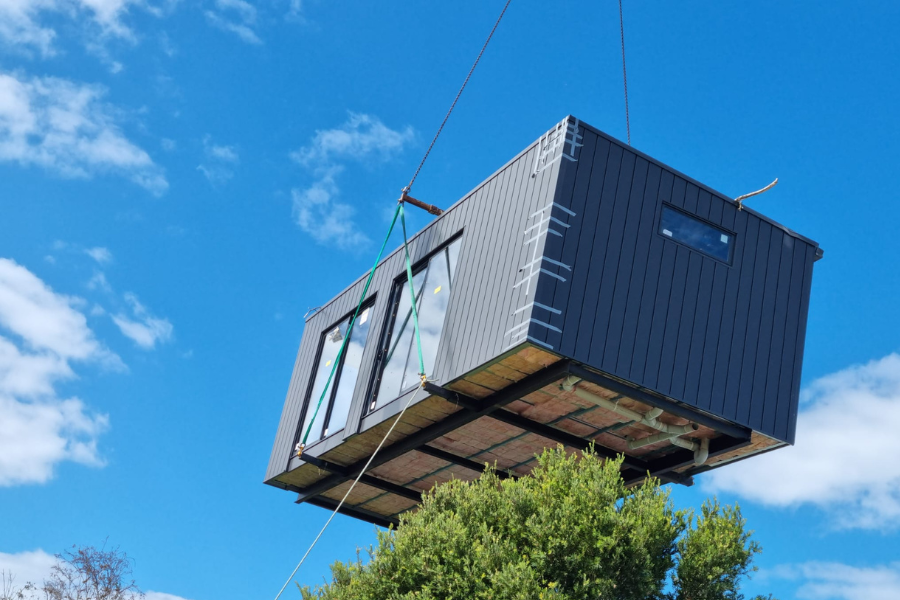Jun 17, 2025
Whetstone Green—Achieving Net-Positive Energy with Less Than 4kW of PV
David Butler’s approach to designing his net-positive energy home centered around one foundational principle: integrate energy efficiency from the outset.
By: Diane Chojnowski

Thanks to advancements in building materials, HVAC technology, and renewable energy, achieving a net-positive home—one that generates as much (or more) energy than it consumes—is now within reach. One such success story is David and Gloria Butler’s home—dubbed Whetstone Green—an inspiring example of how thoughtful design and cutting-edge technology can create a house that meets and exceeds its energy needs.
David Butler is a retired building systems engineer and home performance expert living in the high desert of Whetstone, Arizona. Throughout his career, he specialized in mechanical system design for high-performance homes, including passive solar designs, mini-splits, and ground source heat pumps. His work extended to airflow and refrigeration diagnostics, energy modeling, and life cycle cost analysis. Butler was also active in software development related to building performance and contributed to developing several building science standards. He’s well-known in the home performance industry for fostering professional knowledge-sharing through online communities, having moderated the widely respected Home Performance Forum and a LinkedIn group for home performance contractors.
Whetstone Green sets a new standard for net-positive energy homes. This 3,300-square-foot residence produces 25% more energy than it consumes, while using less than 4kW of photovoltaic (PV) power. Designed and built with energy efficiency at its core, the net-positive home integrates passive solar design, high-performance insulation, and state-of-the-art HVAC and renewable energy systems.
This case study explores the strategies employed in achieving net-positive energy performance and the lessons learned from the project.

Design and Construction Strategies
Site Selection and Orientation
Whetstone Green is situated on a north-facing lot, optimal for passive solar design. Engineered overhangs on all south-facing windows allow strategic daylighting year-round while limiting solar gain in summer and maximizing solar gain in winter. The layout of the home further optimizes thermal efficiency. For example, west-facing glass was kept to a minimum by locating the attached garage on the west end, while east-facing glass maximizes solar gain in bedrooms and baths on cold winter mornings.
High-Performance Enclosure
The building envelope of Whetstone Green is a standout feature in its energy performance. Above-grade walls are framed with 2×6 construction spaced 24 inches on- center and insulated with an R-23 blown-in blanket system (BIBS), supplemented by R-4 exterior expanded polystyrene (EPS) for continuous insulation. Below-grade walls use 2×4 framing with R-13 fiberglass batts plus R-6 of continuous EPS.

The roof is insulated with 9 inches of open-cell spray polyurethane foam (ocSPF), achieving about R-33, and the floor truss ledgers are covered with 6 inches of ocSPF for roughly R-22. High-performance vinyl windows contribute to the home’s thermal efficiency, with a U-factor of 0.28 and a solar heat gain coefficient (SHGC) of 0.19. Exceptional air sealing was also achieved, with an air tightness rating of 0.52 air changes per hour at 50 Pascals (ACH50). The “flat” roof is coated with a special paint with high reflectance and emissivity ratings to reduce cooling loads.

Mechanical and Energy Systems
HVAC and Ventilation
Butler installed a 1-ton variable speed heat pump (Carrier 18VS) to maintain year-round comfort with minimal energy consumption. Paired with a variable-speed fan coil and a 4-zone Infinity system control, this setup delivers precise temperature control and energy savings. A 3kW electric heat kit and two small built-in space heaters—a 134-watt embedded floor heater in the desk seating area and a 300-watt convection heater in the master bath—provide supplemental heat.
All ductwork is routed through the floor trusses, thus located entirely within conditioned space. The return system is ductless, which is particularly effective in basement homes since below-grade spaces rarely call for heat or cooling. A duct blaster test confirmed minimal air leakage (16 ACH25), reinforcing overall energy efficiency. For ventilation, a custom-built economizer delivers outdoor air, providing “free” cooling during spring and fall nights. This system, controlled by sensors and a small, dedicated CPU, reduces the home’s annual cooling loads by roughly 20%.
Renewable Energy System
A ground-mounted PV system powers the home’s energy needs. Comprising twelve 320-watt LG solar panels and Enphase IQ 6+ micro-inverters, the array totals 3,840 watts of capacity. The array is tilted at 30 degrees and oriented South for optimal solar exposure. Originally modeled to produce 7,600 kilowatt-hours annually—about 110% of the home’s projected energy load—the system has consistently outperformed expectations. Over its first two years, it generated an average of 7,910 kWh/yr; in the most recent two-year period, it produced 7,790 kWh/yr.

Performance Analysis
Energy Consumption vs. Production
Butler initially modeled the home to consume only 6,900 kilowatt-hours annually, but actual usage has been even lower. During its first two years, the residence used an average of 6,280 kilowatt-hours per year. More recently, the average rose slightly to 6,725 kilowatt-hours, still well below the solar system’s energy production. This performance translates to a net-positive energy profile, with solar output initially exceeding consumption by nearly 26%.
Heating and Cooling Performance
The HVAC system has proven highly effective, even under extreme weather conditions. In its first summer, before applying the high-reflectance roof coating, the indoor temperature only rose slightly above the cooling setpoint during an extreme heat wave. However, once the roof coating was applied, the system is now able to maintain indoor comfort at 78°F even when outside temperatures soared to 105°F. Auxiliary heating elements have seen minimal use, with the heat pump’s backup strips averaging only 44kWh/yr and the built-in space heaters averaging about 30 kWh annually.
Design Decisions That Made the Difference
Butler’s approach to designing Whetstone Green centered around one foundational principle: integrate energy efficiency from the outset. Rather than designing first and then adding performance features to the basic design, he believes energy goals must shape the layout and even lot selection from the beginning. Many of the most effective strategies—such as thoughtful site orientation, strategic window placement, and engineered overhangs—cost little if anything to implement yet yield substantial gains in comfort and energy savings.
Butler’s integrated design philosophy also guided mechanical system selections. For example, his choice of a 1-ton heat pump initially drew skepticism from other home performance experts who thought it would be too small for the home’s needs. Yet, by pairing that right-sized equipment with passive design, thermal mass, and load diversity, the system has consistently maintained indoor comfort—even during temperature extremes—while operating with impressive efficiency.
Real-world performance has also confirmed another of Butler’s guiding beliefs: energy modeling is a valuable tool but not infallible. Models often overestimate heating loads in well-designed homes, failing to account for thermal mass, internal gains, and passive solar contributions. Observed performance at Whetstone Green—where actual consumption came in below modeled predictions—demonstrates the importance of validating designs through data, not just simulations.
The basement design also played a crucial role in the home’s success—the home benefits from natural thermal stability by locating nearly half the conditioned spacebelow grade. Butler went a step further by installing removable ceiling tiles in the basement, offering access for repairs and the flexibility for future upgrades to wiring, plumbing, or mechanical systems without cutting into walls or ceilings.
A Model for Net-Positive Design
Whetstone Green is a model for achieving net-positive energy with a modest PV system and careful attention to energy-efficient design. Butler achieved sustainability and a comfortable and cost-effective living environment by carefully designing the home with passive solar, cost-effective insulation, high-performance HVAC, and renewable energy strategies. This innovative home demonstrates the real-world viability of net-positive homes in hot climates and sets new standards for the future of high-performance residential construction.
This article is part of a series of stories highlighting innovation in home energy efficiency. Do you have an energy-saving solution or project you’d like to share? I’d love to hear from you. Reach out to me at dchojnowski@building-performance.org.
Resources
Whetstone Green: Net Positive Plus 25%… on Less than 4kW!—presentation at the
2024 Dry Climate Forum.
The Elephant in the Room – HVAC for High Performance Homes—presentation at the
2009 RESNET Conference.
David & Gloria Butler’s former home—an energy efficient Mediterranean style home in
Mecklenburg County near Charlotte, NC (1999).
All images courtesy of David Butler.





